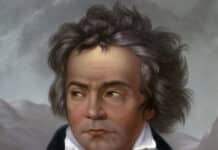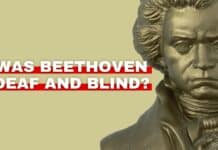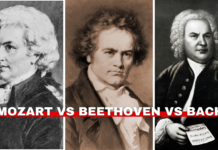Hungary is a land of musicians, from the renowned classical composer Johann Strauss to the folk music bands still playing on village streets. It’s no wonder that Hungary has produced numerous famous composers in its history. Here are just a few.
1) Franz Liszt
Liszt, born in 1811, was considered a child prodigy. He is considered as one of the greatest pianists ever to live, he toured throughout Europe and America giving concerts; his appearances included duets with many other famous musicians and composers such as Franz Schubert and Felix Mendelssohn. Most of his compositions were for piano solo or for piano with voice and orchestra. As well as piano music, Liszt wrote songs (and collected folk songs from Hungary), lieder, orchestral works including symphonies, sacred choral works including masses (he conducted these in Rome’s Church of San Lorenzo), operas, and even a symphony for organ. He died in 1886.
He was born in 1811 and died in 1886, and like many other composers from this country spent most of his career touring Europe, giving concerts for audiences everywhere. But unlike some, he wasn’t just a pianist; he was also a composer and conductor. After 1847 he stopped touring to concentrate on composing, which is when his career as a composer took off. Liszt wrote operas, symphonies, piano music, choral works including masses and oratorios (he conducted the latter two at the Church of St. Stephen in Vienna), lieder (songs for voice and piano), organ pieces, orchestral works like overtures and suites the list goes on! His influence has stretched into many other fields far removed from music; poets Lord Byron and Oscar Wilde were inspired by his work to write poems about him.
2) Béla Bartók
Bartók was born in 1881 and died in 1945. He is considered one of the great innovators in symphonic music and referred to as the “Magyar Beethoven.” His style is unmistakable, with its strong rhythms and harmonies, the contrast between beautiful melodies and disturbing dissonance, mastery of counterpoint (using more than one melodic line at once), a love for folk music of his native country, and desire to find beauty within the natural world. Several sets of his works have become standard: Mikrokosmos for piano solo (this collection contains many short pieces that are not only fun to play but also give insight into Bartók’s compositional style), the three violin sonatas, and the two piano concertos.
3) Joseph Haydn
In addition to being a famous composer, Haydn was also an accomplished music teacher who taught many other famous musicians, such as Ludwig van Beethoven and Franz Schubert. He worked with Prince Nikolaus Esterhazy for nearly thirty years before finally leaving his service in 1790 to work for another prince – only this time it was the Emperor of Austria. His name is often associated with Johann Sebastian Bach because he turned away from the Baroque-style writing that had been popular back then towards what would later become known as Classical Style. One of his best-known works is The Creation. He died in 1809 at the age of 76.
4) Péter Eötvös
Péter Eötvös was born in 1954 and is still alive today, though his works are slowly being performed less often. A famous contemporary composer, his music tends to be melodic but with an avant-garde style that has influenced an entire generation of Hungarian composers (and some who aren’t Hungarian). As far as instruments go, he writes for all the typical ones you’d expect: chorus, orchestra, piano solo, etc., and writes for unusual combinations of instruments such as the marimba quartet. His compositions have been performed throughout Europe and the United States at Carnegie Hall, the Los Angeles Music Center, and the Hungarian State Opera House.
5) Franz Schubert
Franz Schubert was born in 1797 and died in 1828 at the age of 31; and is as well-known for his wonderful music as he is for dying young. It’s often said that what we consider to be Romanticism in the arts (which stretched from the late 1700s until World War One) started with a string quartet he wrote called Death and the Maiden, published shortly before his death.
Schubert wrote pieces across genres, including symphonies, chamber music such as string quartets and piano trios, choral works like masses, and a great many songs that other famous composers often performed. He was also the teacher of some other famous composers, including Johannes Brahms and Robert Schumann, who would later become two of his greatest fans and champions.
6) Ernst von Dohnányi
Ernst von Dohnányi was born in 1985 and is still alive today as well, though he retired from composing in 2007 at the age of 60 (go figure). He started his musical career being trained by some other famous Hungarian composers, including Kodály and Bartók, both of whom we’ll discuss later on this list. It was with Bartók that he went on a world tour when he was 14 years old! It’s thought that this tour inspired him to compose pieces like his First Violin Concerto, which was written in 1927. After 1956, he lived for many years in West Germany, where he tried to keep his musical style from slipping into modernism (which was very popular). Still, his style gradually changed towards more traditional styles of composition.
7) Erno Dohnányi
Ernst von Dohnányi’s father and another one of Hungary’s great composers! Erno Dohnányi was born in 1888 and died in 1968 at the age of 80; like his son, he began studying music right out of high school when he was 15 years old. After studying with Bartók, Kodály, and Székely, he became a professor of composition at the Budapest Conservatory in 1921. Then after 1956, he ended up being one of the most influential figures in Hungarian music education because of his work as an administrator at them (he was appointed rector there in 1961).
8) László Hortobágyi
László Hortobágyi was born in 1915 and died 1962 at the age of 47; he studied music composition under Zoltán Kodály in Budapest from 1936 to 1939 where we see a lot of Hungarian musical nationalism starting to have an influence on others besides Béla Bartók, Zoltán Kodály, and Franz Liszt (though I still think Bartok’s music had a stronger nationalist sound than anyone else’s). After 1956 he taught at the Franz Liszt Academy of Music in Budapest, and he was also a member of the Hungarian Parliament for four years (in 1961).
The biggest mark that Hortobágyi made on musical history, though, was his composition of the Olympic Fanfare and Theme, which ended up being used as a symbol for the 1968 Summer Olympics in Mexico City, so it’s still known today.
9) Zoltán Kodály
Zoltán Kodály was born in 1882 and died in 1967 at the age of 85; like Ferenc Liszt, he went to Budapest to study music composition under an eminent teacher, but Kodály’s teacher was not Franz Liszt (but rather Professor Hans Koessler). He taught him in Budapest from 1902 until 1909. After that, Kodály studied with Max Bruch in Berlin for a year (1909-1910), then again in Budapest with Leo Weiner until 1914, after which he went to Italy for one more year of studying; before finally going back home! He didn’t write his first pieces until 1917, though when he wrote a piece called “Romantic Suite” and another titled “Improvisations” for violin and piano.
Table of Contents






